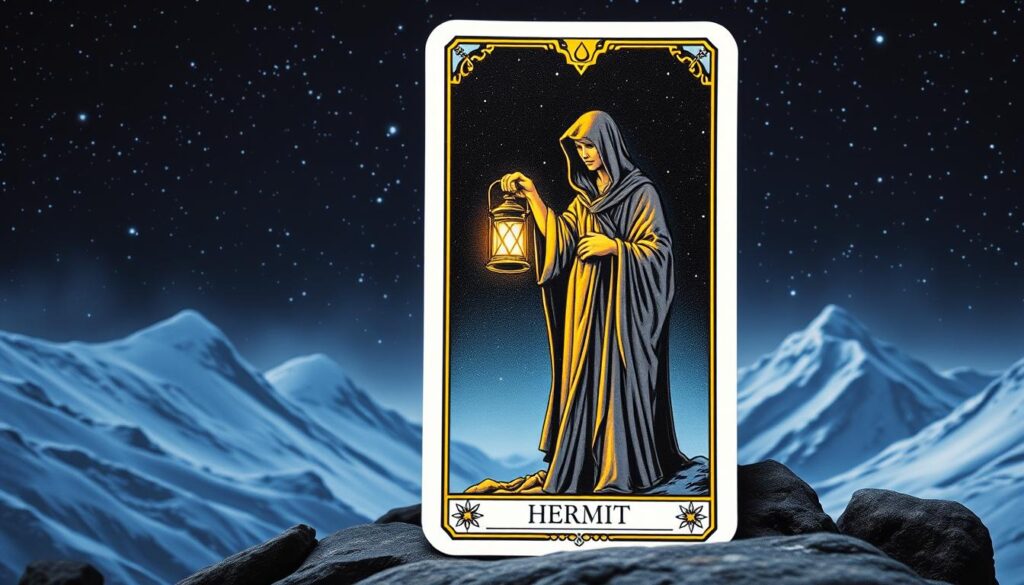Embarking on a journey of self-discovery often requires stepping away from the noise of everyday life. The Hermit, a powerful card in the Major Arcana, serves as a trusted companion for those seeking deeper understanding. It’s not about loneliness but intentional solitude, a space where inner wisdom can flourish.
This card often appears during pivotal life transitions, offering guidance through introspection. Think of it as an inner GPS, helping you navigate challenges with clarity. Real-world examples, like Christopher McCandless’s wilderness journey, highlight how solitude can lead to profound personal growth.
In today’s fast-paced world, The Hermit reminds us to embrace practices like digital detoxes and mindfulness. It’s about balancing inner work with daily responsibilities. Whether you’re on a spiritual retreat or simply taking a quiet moment, this card encourages you to reconnect with your inner light.
Key Takeaways
- The Hermit represents intentional solitude, not loneliness.
- It’s a guide for introspection and self-discovery.
- Appears during life transitions, offering clarity.
- Encourages practices like mindfulness and digital detoxes.
- Symbolizes inner wisdom and personal growth.
Introduction to The Hermit Tarot Card
Wisdom often blooms in the stillness of solitude. This tarot card, a beacon of introspection, invites you to pause and reflect. It’s not about escaping the world but finding a deeper connection with yourself.

The Symbolism Behind The Hermit
Every element in this tarot card carries meaning. The lantern, with its six-pointed star, symbolizes divine wisdom. It’s a light guiding you through life’s uncertainties. The staff represents authority and support, reminding you to trust your inner strength.
In the background, the mountain signifies accomplishment. It’s a reminder that the path to self-discovery is often steep but rewarding. Together, these elements create a powerful metaphor for personal growth.
Why Solitude Is a Powerful Teacher
Solitude isn’t about loneliness. It’s a chance to recharge and reflect. Take Christopher McCandless’s journey into the wilderness. His time alone led to profound insights about life and purpose.
In today’s fast-paced world, moments of introspection are rare. Yet, they’re essential for clarity. A recent study found that 78% of meditation practitioners report increased mental clarity. This shows how valuable quiet moments can be.
| Symbol | Meaning |
|---|---|
| Lantern | Wisdom and guidance |
| Staff | Authority and support |
| Mountain | Accomplishment and growth |
Whether you’re on a spiritual retreat or simply taking a quiet walk, this tarot card encourages you to embrace solitude. It’s a reminder that sometimes, stepping back is the best way to move forward.
Upright vs. Reversed Meanings of The Hermit
Understanding the duality of this card reveals its deeper lessons. Whether upright or reversed, it offers unique insights into solitude and introspection. Let’s explore both sides to uncover its full meaning.

Seeking Inner Light
When upright, this card symbolizes strategic withdrawal for clarity. It’s not about escaping but finding inner wisdom. Think of weekend retreats or spiritual pilgrimages. These moments of contemplation help recharge and refocus.
Mercury’s influence is often tied to this position, encouraging introspection cycles. It’s a reminder to trust your inner guidance. For example, taking a break from work can prevent burnout and restore balance.
Isolation or Overwhelm?
In its reversed position, the card warns of unhealthy isolation. A recent study found that 42% of remote workers report unwanted loneliness. This mirrors the reversed theme of feeling disconnected.
It’s crucial to recognize the spectrum of isolation. Too little can lead to burnout, while too much can cause overwhelm. For instance, a relationship sabbatical might help some but strain others.
| Position | Interpretation |
|---|---|
| Upright | Strategic withdrawal, inner wisdom, clarity |
| Reversed | Isolation, overwhelm, unhealthy withdrawal |
To assess your needs, try this journal prompt: “How does solitude enhance my intuition and growth?” It’s a simple way to reflect on your life and balance.
Watch for warning signs like persistent avoidance of social interactions. These could indicate unhealthy withdrawal. For more guidance, explore this resource on balancing solitude and connection.
The Hermit’s Guidance for Love and Relationships
Navigating love and relationships often requires moments of introspection. This card’s energy encourages balance between connection and independence. Whether you’re single or partnered, it offers valuable insights into emotional growth.

Upright Love: Time for Self-Discovery
When this card appears upright, it signals a need for self-reflection. Taking time alone can strengthen your bond with others. Studies show that 68% of couples report improved communication after solo retreats.
Consider activities like partnered journaling or scheduled alone time. These practices foster deeper understanding and reignite passion. As one partner shared, “Solo travel helped me reconnect with my partner in a meaningful way.”
Reversed Love: Navigating Distance or Loneliness
In its reversed position, this card warns of emotional withdrawal. It’s essential to differentiate healthy introspection from avoidance. For instance, using “Hermit energy” to justify unavailability can strain a relationship.
If you’re feeling disconnected, try reconnection rituals. Simple acts like sharing your day or planning a date night can bridge the gap. Remember, “I need space but value us” is a powerful communication script.
- Healthy introspection vs. emotional avoidance.
- Partnered journaling sessions as a date night idea.
- Red flag: Justifying emotional unavailability with solitude.
- Surprising benefit: Solo travel enhances relationship EQ.
The Hermit’s Career and Financial Wisdom
Finding clarity in your career often starts with a moment of pause. This card’s energy encourages introspection, helping you align your professional path with your inner values. Whether you’re navigating a career shift or seeking financial balance, its lessons are invaluable.

Finding Purpose in Your Work
Many people feel stuck in jobs that don’t fulfill them. A Pew Research study found that 53% of millennials prioritize purpose over salary. This shift highlights the importance of aligning your work with your deeper goals.
Consider intentional career pauses. Unlike quiet quitting, these breaks allow you to reflect and recharge. For example, transitioning from a corporate lawyer to a mindfulness coach can bring newfound meaning to your way of life.
“Your career should nourish your soul, not just your bank account.”
Rethinking Material Success
Financial independence is a popular goal, but it’s essential to define what success means to you. The FIRE movement (Financial Independence, Retire Early) emphasizes saving aggressively, but it’s equally important to focus on what truly funds your happiness.
Anti-budgeting is a growing trend. Instead of strict spending limits, it encourages intentional spending. This approach aligns with the card’s emphasis on inner wisdom over external validation.
- Quiet quitting vs. intentional career pauses.
- FIRE movement: Balancing savings with personal fulfillment.
- Side hustle culture: Monetizing vs. soul-nourishing work.
- LinkedIn profile audit: Aligning your online presence with your true self.
| Traditional Approach | Intentional Approach |
|---|---|
| Focus on salary and promotions | Prioritize purpose and alignment |
| Strict budgeting | Intentional spending |
| Continuous work without breaks | Strategic career pauses |
Creating a Hermit-inspired office setup can enhance focus. Simple changes like decluttering or adding a meditation corner can make a big difference. Remember, the world rewards those who take time to reflect and realign.
The Spiritual Mentor in The Hermit
Spiritual growth often begins with finding the right guide. This card embodies the essence of a mentor who helps you connect with your inner wisdom. Unlike traditional gurus, a wisdom facilitator encourages self-discovery rather than dictating answers.
Identifying true mentors can be challenging in today’s world of spiritual influencers. Look for those who prioritize your growth over their popularity. A genuine mentor will guide you to your own light, not just their teachings.

Shadow work is a powerful tool for integrating lessons from this card. It involves exploring hidden aspects of your self to achieve balance. Combining this with ancestral wisdom, as seen in the Hierophant’s teachings, can deepen your connection to past generations.
Try the “Lantern Visualization” meditation for decision-making. Imagine holding a lantern that illuminates your path, revealing clarity in moments of doubt. This technique aligns with the card’s symbolism of guidance.
Modern mystics like Julia Cameron, author of The Artist’s Way, exemplify this energy. Her practices encourage creativity through introspection, showing how solitude can fuel personal growth.
Be cautious of spiritual bypassing, where introspection is used to avoid real issues. True growth requires facing challenges, not escaping them. Building a community of like-minded individuals can support your spiritual journey.
| Mentor Type | Key Traits |
|---|---|
| Wisdom Facilitator | Encourages self-discovery, focuses on your growth |
| Spiritual Influencer | Prioritizes popularity, often prescriptive |
Shared introspection within a community fosters deeper connection and mutual growth. Whether through group meditations or discussions, this collective energy amplifies individual insights.
Astrology and Numerology of The Hermit
Exploring the deeper layers of tarot reveals connections to astrology and numerology. These systems enrich our understanding of the major arcana, offering insights into the Hermit’s symbolism. By decoding these ties, we uncover a richer narrative of introspection and growth.

Virgo’s Earthy Influence
This card is closely linked to Virgo, an earth sign ruled by Mercury. This connection emphasizes practicality and analytical thinking. Virgo’s energy encourages self-improvement and attention to detail, mirroring the Hermit’s quest for inner wisdom.
During Virgo season, rituals like journaling or decluttering can enhance self-awareness. A birth chart exercise focusing on the 9th house themes can also reveal areas for growth. These practices align with the card’s emphasis on introspection.
The Power of the Number 9
In numerology, the number 9 symbolizes completion and spiritual awakening. It’s linked to the Moon card, both exploring mysteries and inner worlds. This number reflects the Hermit’s journey of self-discovery and the culmination of cycles.
Calculating your personal year number can provide guidance during pivotal moments. For example, if your personal year is 9, it’s a time for reflection and releasing what no longer serves you. This aligns with the card’s energy of shedding old patterns.
- Virgo season rituals: Journaling, decluttering, and self-care practices.
- Birth chart exercise: Identifying 9th house themes for personal growth.
- Numerology hack: Calculate your personal year number for clarity.
- Tarot spread idea: “Hermit’s Mirror” for shadow work and introspection.
How to Apply The Hermit’s Lessons in Everyday Life
Integrating moments of solitude into your daily routine can transform your approach to life. These practices, inspired by introspection, help you find clarity and purpose. Whether you’re seeking personal growth or a deeper connection with yourself, these actionable tips can guide your path.
Start with a morning routine hack called “Hermit Hour.” Dedicate the first hour of your day to intention-setting and reflection. This practice, rooted in mindfulness, helps you align your actions with your inner values. Studies show that 15 minutes of daily reflection can significantly improve mental clarity and focus.

Set tech boundaries to create mental space. Use app limits to reduce distractions and foster a sense of calm. This approach mirrors the intentional withdrawal from societal noise, allowing you to reconnect with your inner wisdom.
Nature immersion is another powerful tool. Urban hiking alternatives, like exploring local parks or green spaces, offer a chance to reconnect with the environment. These moments of solitude can inspire creativity and personal growth.
Creative expression, such as solitude art journaling, encourages self-discovery. Use prompts to reflect on your thoughts and emotions. This practice aligns with the Hermit’s journey of introspection and wisdom-sharing.
For learning on the go, curate a podcast playlist for introspective commutes. Choose episodes that inspire reflection and personal growth. This habit turns everyday moments into opportunities for self-improvement.
Community programs like wisdom-sharing circles foster collective growth. These gatherings encourage mutual support and the exchange of insights. Accountability partners can also help you stay on track with your goals.
Track your progress with milestones that reflect your journey from isolation to integration. Celebrate small wins and reflect on lessons learned. This structured approach ensures continuous growth and self-awareness.
| Practice | Benefit |
|---|---|
| Hermit Hour | Sets intentions, improves focus |
| Tech Boundaries | Reduces distractions, fosters calm |
| Nature Immersion | Inspires creativity, reconnects with nature |
| Art Journaling | Encourages self-expression, reflection |
| Podcast Playlist | Transforms commutes into learning opportunities |
| Wisdom Circles | Fosters community, shared growth |
| Progress Tracking | Ensures continuous improvement |
By applying these lessons, you can create a balanced and fulfilling way of life. Embrace solitude as a tool for growth and self-discovery, and let it guide you toward a deeper understanding of yourself and the world around you.
Common Misconceptions About The Hermit
Many people misinterpret the essence of solitude, often confusing it with isolation. A recent survey found that 63% associate this tarot card with being antisocial. However, this couldn’t be further from the truth. Solitude is about intentional reflection, not avoiding others.

Let’s debunk five common stereotypes. First, it’s not about cutting ties with society. Second, it doesn’t mean you’re lonely. Third, it’s not a sign of weakness. Fourth, it’s not a permanent state. Fifth, it’s not selfish. Solitude is a tool for growth, not a retreat from life.
There’s a fine line between healthy retreats and dangerous extremes. While some find clarity in solitude, others may fall into cult-like isolation. It’s crucial to recognize the difference. Healthy solitude fosters connection with oneself, while unhealthy isolation disconnects you from others.
Culturally, perspectives on solitude vary. Nordic friluftsliv emphasizes outdoor connection, while Japanese hikikomori represents extreme withdrawal. Both highlight the importance of balance. Thoreau’s Walden is often misunderstood as complete isolation, yet he maintained social ties and hosted gatherings.
“Solitude is not the absence of company but the presence of oneself.”
Social media detox is often confused with Hermit mode. While both involve stepping back, the former is temporary, and the latter can become a lifestyle. A psychologist notes, “Solitude, when balanced, enhances mental clarity and emotional resilience.”
Take this quick quiz: Is your solitude healthy or harmful? If it recharges and inspires you, it’s healthy. If it isolates and overwhelms you, it’s time to reassess. A tarot reader once confessed, “I used to misinterpret this card as a call to withdraw completely. Now, I see it as a guide to inner wisdom.”
Thoreau’s Walden revisited shows that solitude is about deliberate living, not escape. He used technology when it served him and stayed connected with friends. His experiment was a balance of introspection and engagement.
In today’s world, understanding the true meaning of solitude is more important than ever. It’s not about rejecting society but finding a deeper connection with yourself. Embrace solitude as a path to growth, not isolation.
Conclusion
Every journey inward holds the key to unlocking profound personal growth. Whether upright or reversed, this tarot card teaches us to embrace introspection as a tool for clarity. Its lessons remind us that solitude is not isolation but a path to deeper understanding.
Take time to reflect daily. Start with just five minutes to reconnect with your inner wisdom. This simple practice can transform your life, helping you navigate challenges with confidence.
As you continue your tarot studies, the Strength card awaits, offering lessons in resilience and balance. Remember, your inner light is a beacon, guiding you forward. Like a lighthouse keeper, you hold the power to illuminate your own self.
Affirm: “My inner light guides wise steps forward.” Share your insights using #HermitWisdom and inspire others on their journeys. Together, we can normalize cyclical introspection and celebrate the growth it brings.

